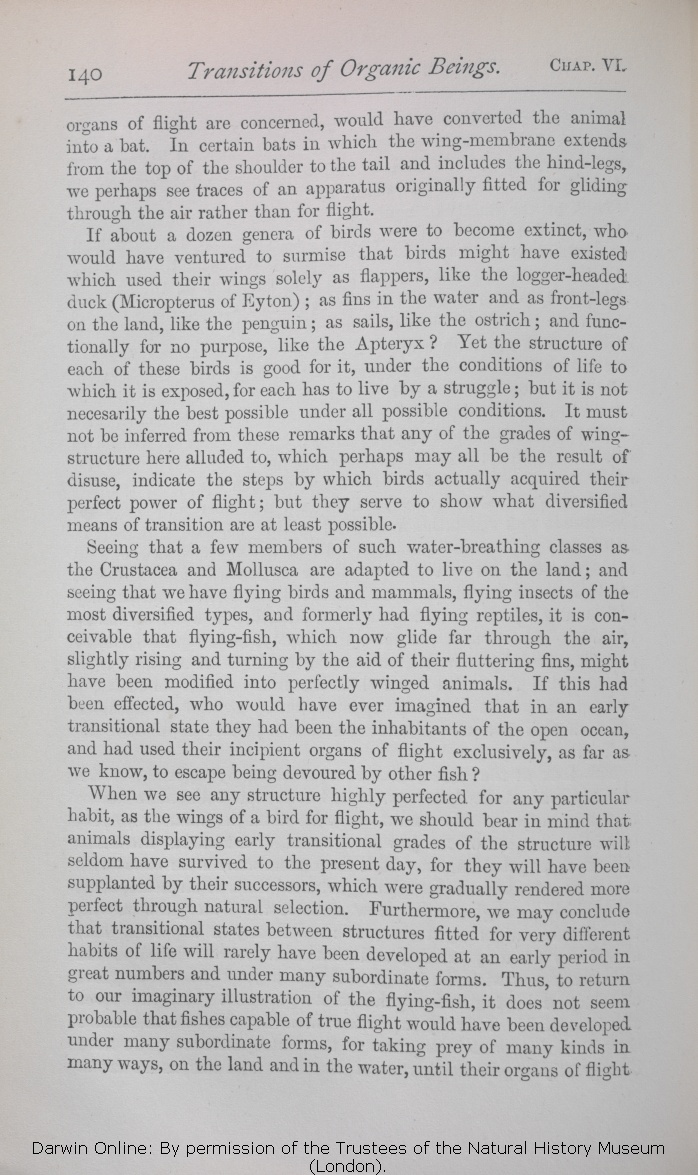organs of flight are concerned, would
have converted the animal | have converted the animal 1872 |
| convert it 1859 1860 1861 1866 1869 |
| certain bats in which 1872 |
| bats which have 1859 1860 1861 1866 |
| certain bats which have 1869 |
| extends 1872 | | extended 1859 1860 1861 1866 1869 |
| tail 1872 | | tail, 1859 1860 1861 1866 1869 |
| and includes 1872 | | including 1859 1860 1861 1866 1869 |
| see 1859 1860 1861 1866 1872 |
| yet see actual 1869 |
| fitted 1869 1872 | | constructed 1859 1860 1861 1866 |
|
|
If about a dozen genera of birds
were to | were to 1872 | | had 1859 1860 1861 1866 1869 |
| extinct, 1872 | | extinct 1859 1860 1861 1866 1869 |
| OMIT 1872 |
| or were unknown, 1859 1860 1861 1866 1869 |
| ..... 1861 1866 1869 1872 | | have 1859 1860 |
| surmise 1861 1866 1869 1872 | | surmised 1859 1860 |
| as front-legs 1872 | | front legs 1859 1860 1861 1866 1869 |
| Apteryx? 1861 1866 1869 1872 | | Apteryx. 1859 1860 |
| be the result of 1872 |
| have resulted from 1859 1860 1861 1866 1869 |
| ..... 1872 | | natural 1859 1860 1861 1866 1869 |
| actually 1872 | | have 1859 1860 1861 1866 1869 |
| serve 1872 | | serve, 1859 1860 1861 1866 1869 |
| to show what diversified means of transition are at least 1872 |
| at least, to show what diversified means of transition are 1859 1860 1861 1866 1869 |
|
|
Seeing that a few members of such water-breathing classes as the Crustacea and Mollusca are adapted to live on the
land; | land; 1860 1861 1866 1869 1872 | | land, 1859 |
| the inhabitants 1869 1872 | | inhabitants 1859 1860 1861 1866 |
|
|
When we see any structure highly perfected for any particular habit, as the wings of a bird for flight, we should bear in mind that animals displaying early
transitional | transitional 1859 1869 1872 | | tran- sitional 1860 1861 1866 |
| have survived to 1872 |
| continue to exist to 1859 1860 1861 1866 |
| exist at 1869 |
| their successors, which were gradually rendered more 1869 1872 |
| the very process of 1859 1860 1861 1866 |
| perfect 1869 1872 | | perfection 1859 1860 1861 1866 |
| transitional 1860 1861 1866 1869 1872 | | transi- tional 1859 |
| states 1869 1872 | | grades 1859 1860 1861 1866 |
| flying-fish, 1859 1860 1861 1869 1872 | | flying-fish; 1866 |
|









